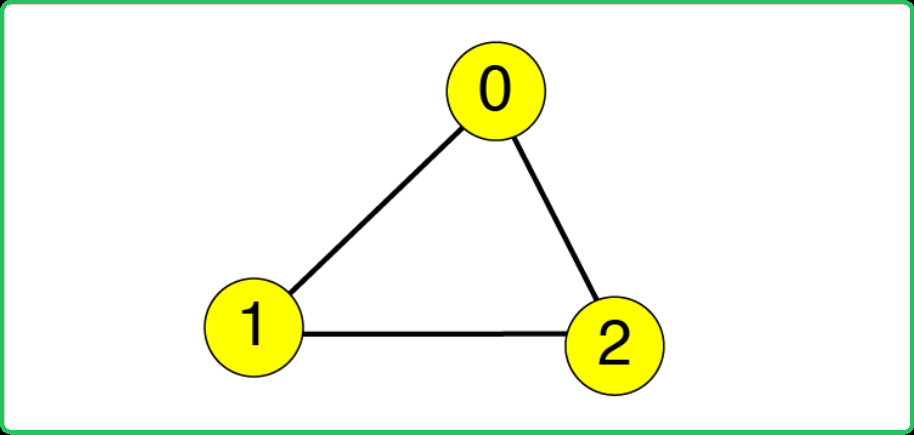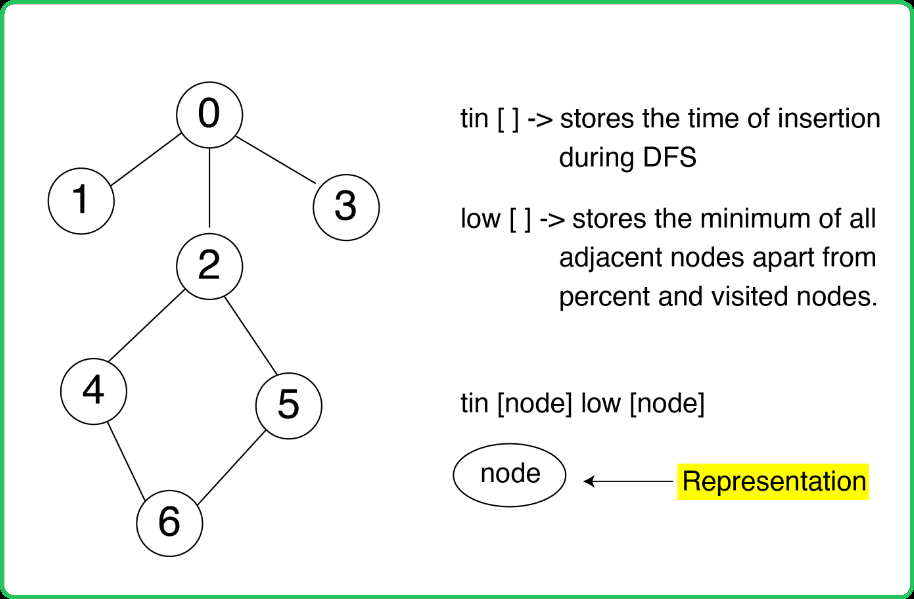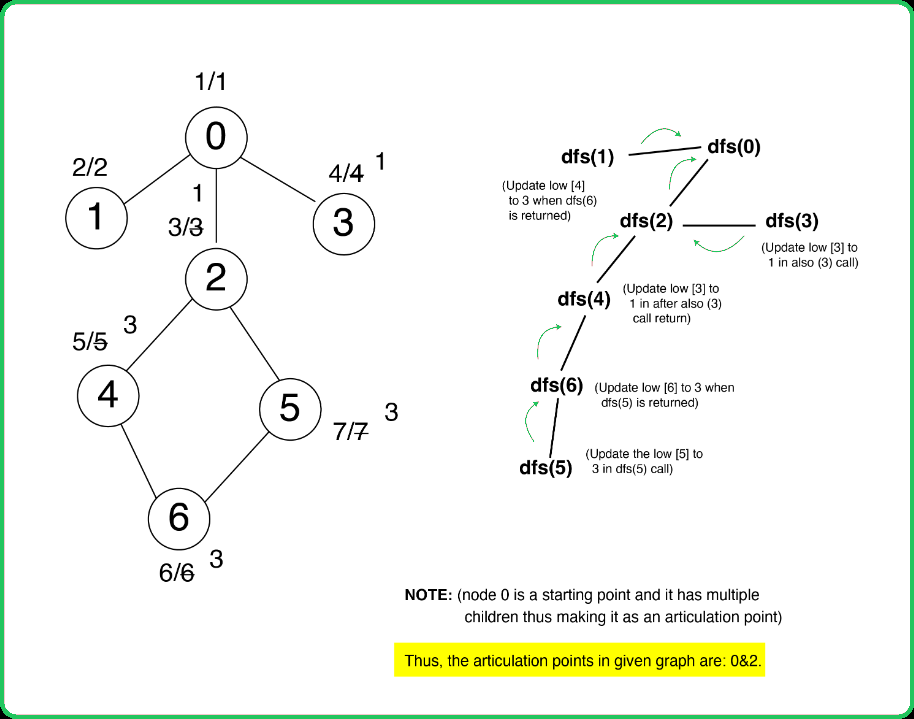123456789101112131415161718192021222324252627282930313233343536373839404142434445464748495051525354555657585960616263646566676869707172737475767778798081828384858687888990919293949596979899100101102103104105106107108109110111112113114115116117118119120121122123124125126127128129130131132133134135136137138139140141142143144145146147148149150
#include <bits/stdc++.h>
using namespace std;
class Solution {
private:
// To store the current time during traversal
int timer = 1;
/* Helper function to make DFS calls while
identifying articulation points */
void dfs(int node, int parent, vector<int> &vis, vector<int> &tin,
vector<int> &low, vector<int> &mark, vector<int>adj[]) {
// Mark the node as visited
vis[node] = 1;
/* Time of insertion and the lowest time of
insert for node will be the current time */
tin[node] = low[node] = timer;
// Increment the timer
timer++;
// To count the number of children of the node
int child = 0;
// Traverse all its neighbor
for (auto it : adj[node]) {
// Skip the parent
if (it == parent) continue;
// If a neighbor is not visited
if (!vis[it]) {
// Make a recursive DFS call
dfs(it, node, vis, tin, low, mark, adj);
/* Once the recursive DFS call returns, upate
the lowest time of insertion for the node */
low[node] = min(low[node], low[it]);
/* If the lowest time of insertion of the node is
found to be greater than the time of insertion
of the neighbor and it is node the starting node */
if (low[it] >= tin[node] && parent != -1) {
// Mark the node as an articulation point
mark[node] = 1;
}
// Increment the child counter
child++;
}
// Else if the neighbor is already visited
else {
// Update the lowest time of insertion of the node
low[node] = min(low[node], tin[it]);
}
}
/* If the node is not a starting node
and has more than one child */
if (child > 1 && parent == -1) {
// Mark the node as an articulation point
mark[node] = 1;
}
}
public:
/* Function to determine the articulation
points in the given graph */
vector<int> articulationPoints(int n, vector<int>adj[]) {
// Visited array
vector<int> vis(n, 0);
// To store the time of insertion(discovery time) of nodes
vector<int> tin(n);
// To store the lowest time of insert of the nodes
vector<int> low(n);
// To mark if a node is an articulation point
vector<int> mark(n, 0);
// Start DFS traversal of the graph
for (int i = 0; i < n; i++) {
// If a node is not visited
if (!vis[i]) {
// Perform DFS starting from that node
dfs(i, -1, vis, tin, low, mark, adj);
}
}
// To store the nodes that are articulation point
vector<int> ans;
// Traverse all nodes
for (int i = 0; i < n; i++) {
// If the node is marked as an articulation point
if (mark[i] == 1) {
// Add it to the result
ans.push_back(i);
}
}
// If there are no articulation points, return -1
if (ans.size() == 0) return { -1};
// Return the result
return ans;
}
};
int main() {
int V = 7;
// Converting graph in adjacency list
vector<int> adj[V] = {
{1,2,3},
{0},
{0,3,4,5},
{2,0},
{2,6},
{2,6},
{4,5}
};
// Creating an instance of Solution class
Solution obj;
/* Function call to get all the
articulation points in the given graph */
vector<int> nodes = obj.articulationPoints(V, adj);
// Output
for (auto node : nodes) {
cout << node << " ";
}
cout << endl;
return 0;
}
123456789101112131415161718192021222324252627282930313233343536373839404142434445464748495051525354555657585960616263646566676869707172737475767778798081828384858687888990919293949596979899100101102103104105106107108109110111112113114115116117118119120121122123124125126127128129130131132133134135136137138139140141142143144145146147148149
import java.util.*;
class Solution {
private int timer = 1;
/* Helper function to make DFS calls while
identifying articulation points */
private void dfs(int node, int parent, boolean[] vis,
int[] tin, int[] low, boolean[] mark,
ArrayList<ArrayList<Integer>> adj) {
// Mark the node as visited
vis[node] = true;
/* Time of insertion and the lowest time of
insert for node will be the current time */
tin[node] = low[node] = timer;
// Increment the timer
timer++;
// To count the number of children of the node
int child = 0;
// Traverse all its neighbor
for (int it : adj.get(node)) {
// Skip the parent
if (it == parent) continue;
// If a neighbor is not visited
if (!vis[it]) {
// Make a recursive DFS call
dfs(it, node, vis, tin, low, mark, adj);
/* Once the recursive DFS call returns, upate
the lowest time of insertion for the node */
low[node] = Math.min(low[node], low[it]);
/* If the lowest time of insertion of the node is
found to be greater than the time of insertion
of the neighbor and it is node the starting node */
if (low[it] >= tin[node] && parent != -1) {
// Mark the node as an articulation point
mark[node] = true;
}
// Increment the child counter
child++;
}
// Else if the neighbor is already visited
else {
// Update the lowest time of insertion of the node
low[node] = Math.min(low[node], tin[it]);
}
}
/* If the node is not a starting node
and has more than one child */
if (child > 1 && parent == -1) {
// Mark the node as an articulation point
mark[node] = true;
}
}
/* Function to determine the articulation
points in the given graph */
public ArrayList<Integer> articulationPoints(int n,
ArrayList<ArrayList<Integer>> adj) {
// Visited array
boolean[] vis = new boolean[n];
// To store the time of insertion(discovery time) of nodes
int[] tin = new int[n];
// To store the lowest time of insert of the nodes
int[] low = new int[n];
// To mark if a node is an articulation point
boolean[] mark = new boolean[n];
// Start DFS traversal of the graph
for (int i = 0; i < n; i++) {
// If a node is not visited
if (!vis[i]) {
// Perform DFS starting from that node
dfs(i, -1, vis, tin, low, mark, adj);
}
}
// To store the nodes that are articulation point
ArrayList<Integer> ans = new ArrayList<>();
// Traverse all nodes
for (int i = 0; i < n; i++) {
// If the node is marked as an articulation point
if (mark[i]) {
// Add it to the result
ans.add(i);
}
}
// If there are no articulation points, return -1
if (ans.size() == 0)
return new ArrayList<>(Arrays.asList(-1));
// Return the result
return ans;
}
public static void main(String[] args) {
int V = 7;
// Converting graph in adjacency list
ArrayList<ArrayList<Integer>> adj = new ArrayList<>();
for (int i = 0; i < V; i++) {
adj.add(new ArrayList<>());
}
adj.get(0).addAll(Arrays.asList(1, 2, 3));
adj.get(1).addAll(Arrays.asList(0));
adj.get(2).addAll(Arrays.asList(0, 3, 4, 5));
adj.get(3).addAll(Arrays.asList(2, 0));
adj.get(4).addAll(Arrays.asList(2, 6));
adj.get(5).addAll(Arrays.asList(2, 6));
adj.get(6).addAll(Arrays.asList(4, 5));
// Creating an instance of Solution class
Solution obj = new Solution();
/* Function call to get all the
articulation points in the given graph */
ArrayList<Integer> nodes = obj.articulationPoints(V, adj);
// Output
for (int node : nodes) {
System.out.print(node + " ");
}
System.out.println();
}
}
123456789101112131415161718192021222324252627282930313233343536373839404142434445464748495051525354555657585960616263646566676869707172737475767778798081828384858687888990919293949596979899100101102103104105106107108109110111112113114115116117118119120121122123124125126127128129130131132133
class Solution:
def __init__(self):
# To store the current time during traversal
self.timer = 1
# Helper function to make DFS calls while
# identifying articulation points
def dfs(self, node, parent, vis, tin, low, mark, adj):
# Mark the node as visited
vis[node] = True
# Time of insertion and the lowest time of
# insert for node will be the current time
tin[node] = low[node] = self.timer
# Increment the timer
self.timer += 1
# To count the number of children of the node
child = 0
# Traverse all its neighbor
for it in adj[node]:
# Skip the parent
if it == parent:
continue
# If a neighbor is not visited
if not vis[it]:
# Make a recursive DFS call
self.dfs(it, node, vis, tin, low, mark, adj)
# Once the recursive DFS call returns, upate
# the lowest time of insertion for the node
low[node] = min(low[node], low[it])
# If the lowest time of insertion of the node is
# found to be greater than the time of insertion
# of the neighbor and it is node the starting node
if low[it] >= tin[node] and parent != -1:
# Mark the node as an articulation point
mark[node] = True
# Increment the child counter
child += 1
# Else if the neighbor is already visited
else:
# Update the lowest time of insertion of the node
low[node] = min(low[node], tin[it])
# If the node is not a starting node
# and has more than one child
if child > 1 and parent == -1:
# Mark the node as an articulation point
mark[node] = True
# Function to determine the articulation
# points in the given graph
def articulationPoints(self, n, adj):
# Visited array
vis = [False] * n
# To store the time of insertion(discovery time) of nodes
tin = [-1] * n
# To store the lowest time of insert of the nodes
low = [-1] * n
# To mark if a node is an articulation point
mark = [False] * n
# Start DFS traversal of the graph
for i in range(n):
# If a node is not visited
if not vis[i]:
# Perform DFS starting from that node
self.dfs(i, -1, vis, tin, low, mark, adj)
# To store the nodes that are articulation point
ans = []
# Traverse all nodes
for i in range(n):
# If the node is marked as an articulation point
if mark[i]:
# Add it to the result
ans.append(i)
# If there are no articulation points, return -1
if len(ans) == 0:
return [-1]
# Return the result
return ans
if __name__ == "__main__":
V = 7
# Converting graph in adjacency list
adj = [
[1, 2, 3],
[0],
[0, 3, 4, 5],
[2, 0],
[2, 6],
[2, 6],
[4, 5]
]
# Creating an instance of Solution class
obj = Solution()
# Function call to get all the
# articulation points in the given graph
nodes = obj.articulationPoints(V, adj)
# Output
for node in nodes:
print(node, end=" ")
print()
123456789101112131415161718192021222324252627282930313233343536373839404142434445464748495051525354555657585960616263646566676869707172737475767778798081828384858687888990919293949596979899100101102103104105106107108109110111112113114115116117118119120121122123124125126127128129130131132133134135136137138139140
class Solution {
constructor() {
// To store the current time during traversal
this.timer = 1;
}
/* Helper function to make DFS calls while
identifying articulation points */
dfs(node, parent, vis, tin, low, mark, adj) {
// Mark the node as visited
vis[node] = true;
/* Time of insertion and the lowest time of
insert for node will be the current time */
tin[node] = low[node] = this.timer;
// Increment the timer
this.timer++;
// To count the number of children of the node
let child = 0;
// Traverse all its neighbor
for (let it of adj[node]) {
// Skip the parent
if (it === parent) continue;
// If a neighbor is not visited
if (!vis[it]) {
// Make a recursive DFS call
this.dfs(it, node, vis, tin, low, mark, adj);
/* Once the recursive DFS call returns, upate
the lowest time of insertion for the node */
low[node] = Math.min(low[node], low[it]);
/* If the lowest time of insertion of the node is
found to be greater than the time of insertion
of the neighbor and it is node the starting node */
if (low[it] >= tin[node] && parent !== -1) {
// Mark the node as an articulation point
mark[node] = true;
}
// Increment the child counter
child++;
}
// Else if the neighbor is already visited
else {
// Update the lowest time of insertion of the node
low[node] = Math.min(low[node], tin[it]);
}
}
/* If the node is not a starting node
and has more than one child */
if (child > 1 && parent === -1) {
// Mark the node as an articulation point
mark[node] = true;
}
}
/* Function to determine the articulation
points in the given graph */
articulationPoints(n, adj) {
// Visited array
let vis = new Array(n).fill(false);
// To store the time of insertion(discovery time) of nodes
let tin = new Array(n).fill(0);
// To store the lowest time of insert of the nodes
let low = new Array(n).fill(0);
// To mark if a node is an articulation point
let mark = new Array(n).fill(false);
// Start DFS traversal of the graph
for (let i = 0; i < n; i++) {
// If a node is not visited
if (!vis[i]) {
// Perform DFS starting from that node
this.dfs(i, -1, vis, tin, low, mark, adj);
}
}
// To store the nodes that are articulation point
let ans = [];
// Traverse all nodes
for (let i = 0; i < n; i++) {
// If the node is marked as an articulation point
if (mark[i]) {
// Add it to the result
ans.push(i);
}
}
// If there are no articulation points, return -1
if (ans.length === 0) return [-1];
// Return the result
return ans;
}
}
// Main
const V = 7;
// Converting graph in adjacency list
const adj = [
[1, 2, 3],
[0],
[0, 3, 4, 5],
[2, 0],
[2, 6],
[2, 6],
[4, 5]
];
// Creating an instance of Solution class
const obj = new Solution();
/* Function call to get all the
articulation points in the given graph */
const nodes = obj.articulationPoints(V, adj);
// Output
for (const node of nodes) {
console.log(node);
}
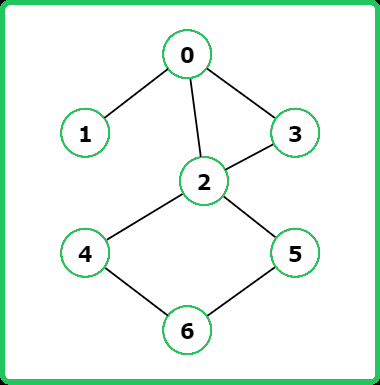
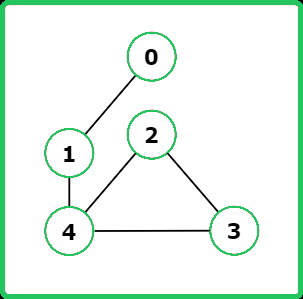
 For the above graph node 0 and node, 2 are the articulation points. If either of the two nodes is removed, the graph breaks into multiple components like the following:
For the above graph node 0 and node, 2 are the articulation points. If either of the two nodes is removed, the graph breaks into multiple components like the following:

